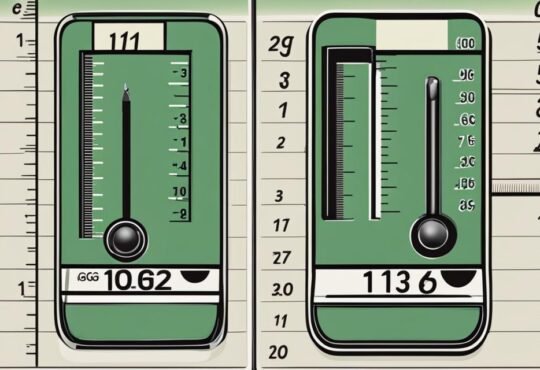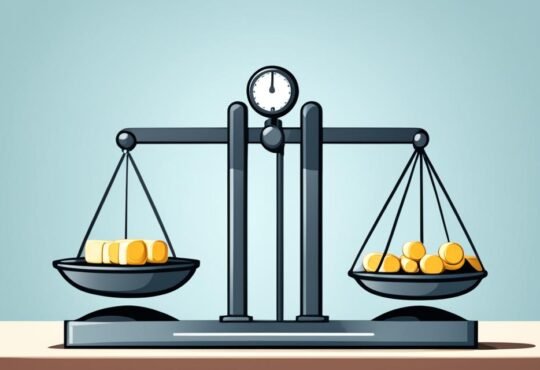
Convert 127g to kg – Quick & Accurate Guide
Converting between different units of measurement can be confusing, but it doesn’t have to be. In this guide, we will provide a quick and accurate way to convert 127 grams (g) to kilograms (kg). By using a simple formula and understanding the relationship between grams and kilograms, you’ll be able to easily make this conversion.
- Converting 127 grams to kilograms is a simple process.
- Use the formula: 127g / 1000 = 0.127 kg.
- Accurate measurement is crucial in cooking and baking.
- Weight measurements are often preferred over volume measurements in baking.
- Understanding cooking and baking abbreviations can be helpful when following recipes.
Contents
Understanding the Metric System
The metric system is a decimal-based system of measurement used worldwide. It provides a simple and consistent way to measure quantities, making it easier to understand and convert between different units. In the metric system, grams (g) are used to measure small mass or weight, while kilograms (kg) are used for larger quantities.
To convert grams to kilograms, you can use a simple formula. Since there are 1000 grams in a kilogram, you divide the number of grams by 1000 to get the equivalent value in kilograms. This conversion makes it easy to switch between the two units of measurement.
“The metric system is a universal language of measurement, making it essential for scientists, engineers, and professionals in various fields.”
Benefits of the Metric System
The metric system offers several advantages over other systems of measurement. Its decimal-based nature allows for easy multiplication and division, simplifying calculations. The use of consistent prefixes, such as kilo-, centi-, and milli-, eliminates the need for complex conversion factors.
The metric system is widely adopted in scientific research, education, and international trade. Its universal use enables seamless communication and collaboration across borders and industries. Additionally, the metric system promotes efficiency and accuracy in measurements, reducing errors and ensuring reliable results.
Conversion Table: Grams to Kilograms
| Grams (g) | Kilograms (kg) |
|---|---|
| 1 g | 0.001 kg |
| 10 g | 0.01 kg |
| 100 g | 0.1 kg |
| 1000 g | 1 kg |
| 5000 g | 5 kg |
Using the conversion table above, you can easily convert grams to kilograms by finding the corresponding value. For example, if you have 500 grams, you can see that it is equal to 0.5 kilograms. This simplifies the process of converting between the two units.
Converting 127g to kg
When it comes to converting grams to kilograms, the process is quite straightforward. For instance, if you have 127 grams that you want to convert into kilograms, all you need to do is divide that number by 1000. That’s right, it’s as simple as dividing by 1000! By using this quick and easy formula, you can convert 127g to kg in just a few steps.
Let’s take a look at the calculation:
127g / 1000 = 0.127 kg
So, if you have 127 grams, it is equal to 0.127 kilograms when converted. Remember, dividing by 1000 is the key to converting grams into kilograms.
Knowing this conversion can come in handy in various scenarios. Perhaps you’re following a recipe that provides measurements in kilograms, and you want to ensure you have the correct amount of ingredients. Or maybe you want to compare the weight of two objects, one measured in grams and the other in kilograms. Regardless of the reason, being able to convert between these units of measurement is a valuable skill.
Conversion Table: Grams to Kilograms
| Grams (g) | Kilograms (kg) |
|---|---|
| 100g | 0.1kg |
| 200g | 0.2kg |
| 500g | 0.5kg |
| 1000g | 1kg |
| 2000g | 2kg |
| 5000g | 5kg |
Referencing the conversion table above can be helpful when you need to convert other gram values to kilograms. Simply divide the number of grams by 1000 to get the equivalent value in kilograms.
Now that you know how to convert 127g to kg, you can confidently tackle any measurement conversion involving grams and kilograms. Whether you’re cooking, baking, or engaged in any other activity that requires accurate measurements, this knowledge will undoubtedly prove useful.
Importance of Proper Measurement in Cooking and Baking
Accurate measurement is crucial in both cooking and baking to ensure consistent results. Whether you’re following a recipe or developing your own, using the proper measurements of ingredients is essential. This is particularly important in baking, where small variations can greatly affect the texture and taste of the finished product. By understanding and using the correct measurements, you can achieve the desired outcome in your culinary creations.
“In cooking, you’ve got to have a what-the-hell attitude.” – Julia Child
Imagine making a cake without measuring the flour or using too much salt in your soup. The result wouldn’t be the same, right? That’s because cooking and baking are scientific processes that require precision. Accurate measurements help maintain the balance of flavors, consistency, and texture in your dishes.
When it comes to baking, the importance of precise measurement is even more critical. Baking is a delicate balance of ingredients that rely on specific ratios for success. Too much or too little of an ingredient can lead to a cake that doesn’t rise, cookies that spread too thin, or a loaf of bread that is dense instead of light and fluffy. The perfect measurement can make the difference between a culinary masterpiece and a disappointing outcome.
By following the recommended cooking measurements, you ensure that each ingredient contributes to the overall flavor profile and texture of the dish. It allows you to replicate your favorite recipes consistently and experiment with new ones confidently.
Here’s a table summarizing some common cooking measurements:
| Measurement | Abbreviation |
|---|---|
| Teaspoon | tsp |
| Tablespoon | tbsp |
| Cup | c |
| Pound | lb |
| Fluid Ounce | fl. oz |
| Quart | qt |
When it comes to baking, precision is key. Experienced bakers know that even a slight variation in measurements can lead to significant differences in the final product. That’s why many professional bakers rely on weight measurements, such as grams and kilograms, rather than volume measurements. Weight measurements provide a more accurate and consistent representation of the ingredients, leaving less room for error.
Why Weight Matters in Baking
Volume measurements can be deceptive, especially when it comes to ingredients like flour. The way you scoop or pack flour can greatly affect its volume, resulting in inconsistent measurements. On the other hand, weight measurements take into account the density and compaction of the ingredients, providing precise and reliable measurements.
By using a kitchen scale to measure ingredients by weight, you can ensure that every cake, bread, or pastry turns out perfectly. Here are some common baking ingredients and their weight equivalents:
| Ingredient | Weight (grams) |
|---|---|
| All-Purpose Flour | 125 g |
| Sugar | 200 g |
| Butter | 225 g |
| Eggs (large) | 50 g |
| Baking Powder | 5 g |
Using weight measurements in baking not only improves the accuracy of your recipes but also allows for better consistency and reproducibility. It takes the guesswork out of the equation and ensures that each batch of cookies or loaf of bread is just as delicious as the last.
So, the next time you embark on a culinary adventure, remember the importance of accurate measurement. Whether you’re cooking a savory meal or indulging in the art of baking, precise measurements will undoubtedly elevate your dishes to new heights.
Common Kitchen Measurement Tools
When it comes to cooking or baking, having the right kitchen measurement tools is essential for precision and accurate results. Whether you’re a professional chef or a home cook, these tools will make your culinary endeavors much easier. Let’s explore the common kitchen measurement tools you should have in your arsenal.
Measuring Spoons
Measuring spoons are indispensable for measuring small quantities of ingredients such as spices, extracts, and baking powder. They come in different sizes, typically ranging from 1/4 teaspoon to 1 tablespoon, allowing you to measure precisely without any guesswork.
Measuring Cups
For larger quantities of dry ingredients like flour, sugar, and oats, measuring cups are a must-have. They come in sets with different sizes, such as 1 cup, 1/2 cup, 1/3 cup, and 1/4 cup, making it easy to measure the exact amount required by your recipe.
Liquid Measuring Cup
When it comes to measuring liquid ingredients like water, milk, or oil, a liquid measuring cup is essential. These cups usually have pour spouts and clear markings indicating volume in ounces or milliliters. This allows you to accurately measure the required liquid without the need for conversion or estimation.
Kitchen Scale
A kitchen scale is a valuable tool when precise measurements by weight are required. It is particularly useful for ingredients like meat, fruits, or vegetables that need to be weighed in grams or kilograms. Using a kitchen scale ensures the accuracy of your measurements, especially when converting between different units of weight.
Having these kitchen measurement tools at your disposal will enable you to follow recipes with confidence and achieve consistent results in your cooking and baking endeavors.
| Measurement Tool | Function |
|---|---|
| Measuring Spoons | To measure small quantities of ingredients accurately |
| Measuring Cups | To measure larger quantities of dry ingredients |
| Liquid Measuring Cup | To precisely measure liquid ingredients |
| Kitchen Scale | To weigh ingredients for accurate measurements |
Cooking and Baking Abbreviations
Understanding cooking and baking abbreviations can be helpful when reading recipes. Some common abbreviations include:
| Abbreviation | Meaning |
|---|---|
| tbsp | tablespoon |
| tsp | teaspoon |
| oz | ounce |
| fl. oz | fluid ounce |
| c | cup |
| qt | quart |
| pt | pint |
| gal | gallon |
| lb | pound |
| mL | milliliter |
| g | grams |
| kg | kilogram |
Knowing these abbreviations will make it easier to follow recipes and accurately measure ingredients.
Importance of Weight in Baking
In baking, weight measurements play a crucial role in achieving consistent and delicious results. Unlike volume measurements, weight measurements provide a more accurate way to measure ingredients. When you measure ingredients by weight, factors like density and compaction are taken into account, ensuring precise measurements that can greatly impact your baked goods. This is especially important when measuring ingredients such as flour, where the volume can vary depending on how it is scooped and packed into a measuring cup.
By using weight measurements, you can eliminate the guesswork and ensure that you’re using the right amount of each ingredient, resulting in consistently delicious creations. Whether you’re a seasoned baker or just starting out, understanding the importance of weight in baking can elevate your skills and help you achieve professional-quality results.
When it comes to flour, for example, measuring by weight provides a more accurate representation of the actual amount needed for a recipe. Flour can easily be compacted in a measuring cup, leading to an incorrect measurement if relying solely on volume. By using a kitchen scale to weigh the flour, you can ensure that you’re using the precise amount called for in the recipe, resulting in a consistent texture and taste.
Incorporating weight measurements in your baking routine also allows for easier recipe scaling. When you need to adjust a recipe to make more or less, using weight measurements ensures accurate proportions, maintaining the integrity of the recipe.
Baking with Precision
“Weight measurements in baking provide accuracy and consistency, giving you the confidence to create perfect treats every time.”
While volume measurements can be convenient, they can often lead to inconsistencies, especially when working with different ingredients and their varying densities. By embracing weight measurements, you can take the guesswork out of your baking and ensure that each ingredient is measured precisely. This level of precision can make all the difference, resulting in beautifully risen cakes, perfectly tender cookies, and flawlessly textured breads.
So, the next time you embark on a baking adventure, consider using weight measurements instead of relying solely on volume. Invest in a reliable kitchen scale and start measuring your ingredients by weight for accurate and consistent results. Your taste buds will thank you!
Conclusion
In conclusion, converting 127 grams to kilograms is a simple process that can be done using the appropriate formula and understanding the relationship between grams and kilograms. By dividing the number of grams by 1000, you can accurately convert 127 grams to 0.127 kilograms. It’s important to note the significance of accurate measurement in cooking and baking to achieve consistent and desirable results.
When it comes to baking specifically, weight measurements are often preferred over volume measurements for their precision. By using a kitchen scale and measuring ingredients by weight, you can ensure that your baked goods turn out deliciously every time. Weight measurements take into account the density and compaction of ingredients, providing more accurate and consistent results compared to measuring by volume.
Understanding cooking abbreviations and utilizing the proper kitchen measurement tools are also key to successful recipe execution. Familiarizing yourself with abbreviations like “tbsp” for tablespoon, “oz” for ounce, and “kg” for kilogram will help you follow recipes more efficiently. Additionally, having essential tools such as measuring spoons, measuring cups, a liquid measuring cup, and a kitchen scale will allow you to accurately measure ingredients and have better control over the outcomes of your culinary creations.
FAQ
How do I convert 127 grams (g) to kilograms (kg)?
To convert 127 grams to kilograms, you divide the number of grams by 1000. Using the formula: 127g / 1000 = 0.127 kg. Therefore, 127 grams is equal to 0.127 kilograms.
Why is accurate measurement important in cooking and baking?
Accurate measurement is crucial in both cooking and baking to ensure consistent results. Whether you’re following a recipe or developing your own, using the proper measurements of ingredients is essential. This is particularly important in baking, where small variations can greatly affect the texture and taste of the finished product. By understanding and using the correct measurements, you can achieve the desired outcome in your culinary creations.
What are some essential kitchen measurement tools?
Some essential kitchen measurement tools include measuring spoons, measuring cups (for dry ingredients), a liquid measuring cup (for liquid ingredients), and a kitchen scale. Measuring spoons are used to accurately measure small quantities of ingredients, while measuring cups are used for larger quantities. A liquid measuring cup allows for precise measurements of liquids, and a kitchen scale is ideal for weighing ingredients that need to be measured by weight, such as when using grams to kilograms conversions.
What are common cooking and baking abbreviations?
Some common cooking and baking abbreviations include tbsp for tablespoon, tsp for teaspoon, oz for ounce, fl. oz for fluid ounce, c for cup, qt for quart, pt for pint, gal for gallon, lb for pound, mL for milliliter, g for grams, and kg for kilogram. Knowing these abbreviations will make it easier to follow recipes and accurately measure ingredients.
Why is weight measurement important in baking?
Weight measurements are often preferred over volume measurements in baking because they provide more accurate and consistent results. When measuring ingredients by weight, the density and compaction are taken into account, resulting in precise measurements. This is particularly important when measuring ingredients like flour, where the volume can vary depending on factors such as how it is scooped and packed into a measuring cup. By using weight measurements, you can ensure that your baked goods turn out consistently delicious.







